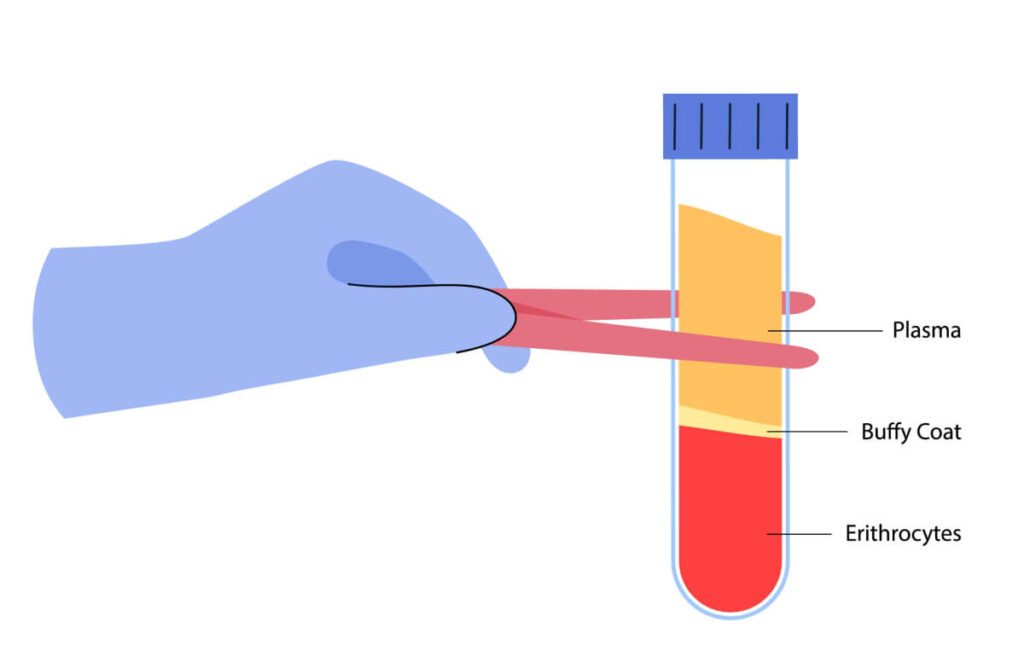PRP injections have been used as an effective hair loss treatment for a few years now. With the platelet-rich plasma found in the patients’ blood cells, the treatment boosts hair growth by directly injecting beneficial growth factors to the scalp which helps scalp health and certain production for hair.
So should PRP injection for hair have a buffy coat? The short answer is yes. While you can have PRP treatments without a buffy coat in the injected serum, the concentrations of platelet-rich plasma solutions without a buffy coat are often subpar compared to when a buffy coat is present in the injections.
Should PRP Injections Have A Buffy Coat?
On a very basic level, the only thing needed for a PRP treatment to treat your type of hair loss is for a blood sample to be taken and have the blood components be separated to isolate the platelet-rich plasma.
But in recent years, there have been studies and conversations on what exactly should be included in the PRP injection solution to give patients the best results. This is why a buff coat is often beneficial to PRP treatments for any medical condition including pattern hair loss.
A buffy coat essentially refers to white blood cells that are included in the PRP solution. While some may see the addition of white blood cells in the solution as a bad thing, studies have shown that the ability of white blood cells to fight off infections, bacteria, and viruses can actually be beneficial to PRP treatments.
With the growth factors and added protection of white blood cells, it’s possible that a buffy coat may actually enhance the wound healing process of PRP treatments for hair growth and will help damaged hair follicles produce new hairs more effectively.
PRP Separation: Centrifuge vs PRP Kits

When separating the components of your blood for PRP, things like platelet-poor plasma, red blood cells, white blood cells, and platelet-rich plasma can all be found in the blood sample. Once everything has been separated you should be left with a high concentration of platelets which can help with hair restoration and hair thinning over time.
While there are standard practices on how to separate the different components to get the highest platelet concentration in the solution, some methods have been proven to be more effective than others. Here are the two most popular ways PRP treatments derive platelet-rich plasma:
1) Centrifuge and Bloody PRP
It’s common practice in the medical field to use just a centrifuge when components of blood need to be separated. While this is a viable option for PRP treatments, the end product that comes out of the centrifuge once all components have been separated has been called out for providing a ‘bloody PRP”.
While a bloody PRP does have a concentration of platelets at around 1.5x of blood platelets, it will also have a concentration of cell types like red and white blood cells. Though white blood cells or the buffy layer can help PRP treatments perform better, the remaining red blood cells do affect the PRP platelet concentration in the injected solution.
Aside from the diluted concentration of platelets, separating the blood components through just a centrifuge won’t only make the treatment less effective but can also cause a number of adverse reactions and side effects.
Though PRP is a safe and relatively risk-free treatment, having a serum with additional components that are not necessary for the procedure could result in avoidable side effects. To ensure the safety of the injected solution and the entire procedure, please seek PRP treatments from a medical professional.
2) PRP Kits
Another way to separate the components of human blood for PRP treatments is by using a PRP kit. While the separation process may differ per kit, this process doesn’t use a centrifuge and will most likely give you a better PRP solution without the risk of having a ‘bloody PRP’.
Most will come with a variety of tubes, transferring tools, butterfly needles, and syringes for administration. PRP kits can also provide a buffy coat for the PRP injections while still not allowing the risk of other components contaminating the entire solution which can render the PRP treatment ineffective.
Here are some of the key features of PRP kits and how they derive a high concentrate solution with a buffy coat:
Using Gel to Separate Blood Components
To enhance the process of separating blood through a centrifuge, PRP kits often use a gel separator to get the job done. At the bottom of each test tube containing the blood sample, medical professionals will place a gel solution to ensure the separation of the samples through osmosis.
With the gel solution at the bottom of the test tubes, other components that aren’t necessary to the PRP solution will stick to the gel and can be easily discarded after. Overall, while the gel may not exactly boost the 1.5x concentration of platelet count, it will provide a better injectable solution and minimize the possible risks.
Visible Buffy Coat
While all kits are different, PRP kits do allow you a better chance of incorporating a buffy coat into the PRP solution for your platelet-rich plasma treatments to address your hair loss. With the thin layer of the buffy coat in the test tube, you’ll be able to see the clear separation of the autologous platelets and blood.
The buffy coat and the platelets can then be separated and used for hair rejuvenation treatment. By adding the buffy coat into the solution, it’s said to have a platelet activation increase of around 5 to 7 times more than the average solution without the buffy coat.
Benefits of A Buffy Coat For PRP

While PRP treatments in itself have an array of benefits from wound healing to hair growth, having a buffy coat layer has been shown to exponentially increase the benefits of platelet-rich plasma therapy.
With the main component of the treatment that boosts hair density and growth being platelet-derived growth factor, having a higher yield or concentration of growth factors is sure to be beneficial to the entire treatment process.
Studies have shown that not only will the solution have an increase in platelets but it will also have better quality platelets to treat hair loss with the addition of a buffy coat in the PRP solution.
Additionally, the buffy coat helps patients recover faster and be less susceptible to side effects of adverse reactions to PRP treatment itself. Though PRP is a nonsurgical treatment of hair loss, there are side effects that can come with it if the solution has not been properly prepared.
With the procedure to the buffy coat filtering through the solution throughout, it’s quite unlikely that particles like red blood cells that could cause issues will remain. Overall, having a buffy coat is beneficial not only for hair growth but also for healing and recovery.
Concerns About White Blood Cells in PRP Therapy For Hair Loss
While it has been proven that having a buffy coat or white blood cells in the PRP solution allows for a larger yield of platelets and boosts its concentration levels, there are some concerns about its inclusion in PRP treatments.
The main concern surrounding white blood cells in PRP treatments is that it could possibly cause inflammation in the area. Due to this possible inflammation, medical professionals are worried that it may cause the growth factors to be ineffective and prevent them from boosting new cell growth in the area.
Without the cell growth, it’s unlikely that PRP would be beneficial in hair growth or as any other type of recovery treatment throughout the body. However, no studies have confirmed that a buffy coat or white blood cells will affect cell regeneration negatively.
Alternative Treatments To PRP

Though PRP has often been seen as one of the most effective treatments to address androgenic alopecia and other types of hair loss, there are other treatment options that can have a similar effect to address your hair loss. Here are some of the best alternative options for anyone wanting to address the appearance of hair thinning and hair loss:
1) Hair Transplant
While a hair transplant will require you to undergo a surgical procedure, hair transplant surgery can be a great option when it comes to addressing hair loss as it offers permanent results. The treatment takes viable hair follicles from the back of your hair and places them onto any area with thinning or balding. After around 6 months, you should see the new hair growth and an increase in hair density.
2) Light Therapy
Another nonsurgical treatment that can possibly address hair loss and androgenic alopecia is light therapy. Using red light specifically, the weak hair cells absorb photos which strengthen them and promote hair regrowth from the root.
Light therapy can also boost the overall health of your scalp and pre-existing hairs. As a non-invasive treatment with virtually no downtime, light therapy is a great option for those who would prefer a procedure without needles or surgery.
3) Topical and Oral Treatments
Topical and oral treatments like minoxidil have been FDA approved and proven to help address a wide range of hair loss concerns. Whether it be applied topically or taken orally, minoxidil can boost hair growth and hair density over time.
For this particular treatment, you should see new hair growth in around 6 to 12 months of regular consumption or application. While it does take a while to reap the benefits, oral and topical treatments are great for people who need to squeeze a quick and easy hair loss treatment in their busy schedules.
Get Quality Medical Supplies for the Right Price at FACE Med Store
While PRP treatments alone are already effective as a hair loss treatment, having a buffy coat in the solution increases its effects and longevity, making it one of the best treatments for hair loss. However, no matter the type of hair loss treatment you choose to do, it’s still important to have the right tools and devices to ensure the safety and success in treating your condition.
Here at FACE Med Store, we offer top quality medical tools and devices at affordable prices to clinics across the country. Contact us today to see our stock list or browse our online catalog.
Learn More: Will Platelet-Rich Plasma Hair Treatment Work for African American Women?






